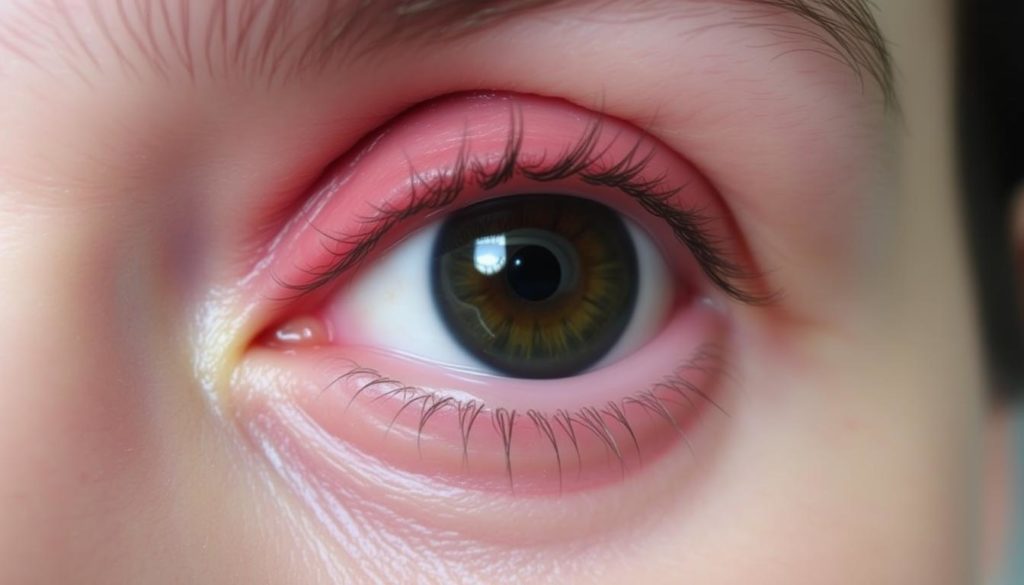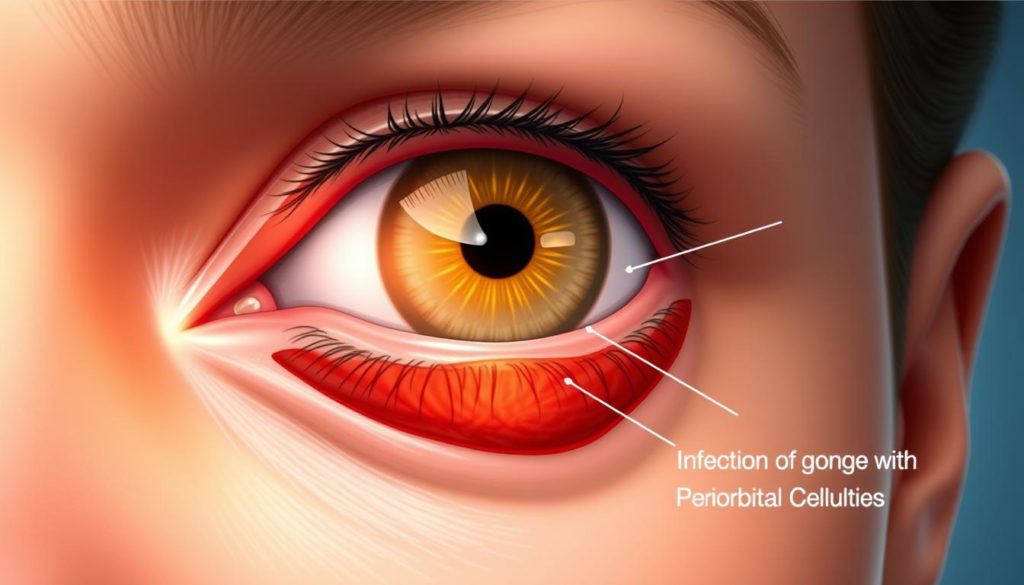Did you know that up to 14% of pediatric emergency cases involving eye infections relate to periorbital cellulitis?
This fact highlights the need to grasp the essence of understanding periorbital cellulitis.
Knowing its causes and optimal care practices is key for swift healing and avoiding further issues.
Periorbital cellulitis attacks the eyelid or skin around it, causing swelling, redness, and pain.
It’s vital to identify its early signs and handle it quickly.
Doing so helps dodge worse problems. A clear periorbital cellulitis explanation helps assess how serious it is.
Then, you can follow the right steps for effective periorbital cellulitis care.
What is Periorbital Cellulitis?
Periorbital cellulitis is a kind of infection. It attacks the eyelid and skin near the eye. It doesn’t go after the inside parts of the eye but focuses on the soft tissues and skin around it. This leads to swelling and the eyelid looking inflamed.

Knowing what periorbital cellulitis is matters a lot. It lets us tell it apart from other eye infections. It shows up as redness, pain, and a warm feeling in the area that’s infected. The swelling can get bad enough to block vision if it’s really severe.
Kids get periorbital cellulitis more than adults, but adults can still catch it. It’s super important to spot and treat it early. Kids might not be great at saying how they feel. Quick action stops the infection from spreading to other face parts or deeper into the eye area. That could lead to big problems.
“Periorbital cellulitis should not be taken lightly; understanding its definition and identifying it early is key to effective treatment.” – Dr. Jane Smith, Ophthalmologist
The area around the eye is easy to infect because of its unique structure. Small injuries, bug bites, or other harm can lead to infection. If signs of infection don’t go away, seeing a doctor right away is important. Quick help can make a big difference and lower the risk of serious issues.
| Aspect | Periorbital Cellulitis | Other Eye Infections |
|---|---|---|
| Affected Area | Skin and eyelid around the eye | Internal components of the eye, like the cornea or conjunctiva |
| Common Symptoms | Redness, swelling, warmth, tenderness | Itching, discharge, visual problems |
| Predominant Demographic | Children | Can be anyone, varies by infection type (like conjunctivitis) |
How Does Periorbital Cellulitis Develop?
Periorbital cellulitis starts when bacteria enter the area around the eye. This can happen through different infection pathways. Most often, bacteria like Staphylococcus aureus or Streptococcus get in through small eye injuries. Sinus infections also play a big role by letting bacteria get to the eyes’ surrounding tissues.
“Understanding the bacterial dynamics is crucial,” says Dr. Samantha Brown, an expert in infectious diseases, “as it helps in delineating effective treatment strategies.”

Bacteria around the eyes are normal but can cause issues when the body’s defenses are down. The infection pathways come from the skin or infections elsewhere in the body. This shows how related our health issues can be.
Let’s explore a few primary infection pathways:
- Sinus Infections: Bacteria can move from the sinuses to the eye area.
- Trauma: Small injuries or surgeries near the eye let bacteria in.
- Skin Infections: Issues like eczema make it easy for bacteria to enter.
Knowing these pathways helps in stopping and treating periorbital cellulitis. Keeping the eye area clean and treating infections early is key.
Recognizing Periorbital Cellulitis Symptoms
Knowing the periorbital cellulitis symptoms is key for quick action and getting better. This problem mainly targets the eyelid and the eye’s nearby areas. Spotting symptoms early helps avoid big health issues.
Common Symptoms to Look For
- Redness and swelling in the eyelid area
- Pain or tenderness around the eye region
- Warmth in the affected area
- Possible discharge from the eye
The top signs of an eye infection include lasting redness and more swelling. Sometimes, a person might also run a fever or feel unwell.
When to Seek Medical Attention
If you notice certain issues, getting medical help for eyelid swelling is crucial. Watch out for:
- Visual changes such as blurred vision
- Difficulty moving the eye
- Intense pain that makes daily tasks hard
Not dealing with these issues quickly can lead to worse problems. Seeing a doctor right away can ensure you get the right help. This lowers the risk of having serious troubles from periorbital cellulitis.
Key Causes of Periorbital Cellulitis
Knowing the periorbital cellulitis causes is key for prevention and treatment. An eye injury is a common cause. It opens the door for bacteria. Cuts or scrapes near the eye can get infected if not cared for well.
Various bacterial eye infections can also lead to periorbital cellulitis. These are often caused by bacteria like Staphylococcus and Streptococcus. These bacteria cause swelling and redness around the eye.
Sinusitis and dental infections are other causes. They allow bacteria to grow and spread to the eye area. Skin wounds or insect bites near the eyes can also cause infections.
Here’s a quick list of what causes periorbital cellulitis:
- Eye injury
- Bacterial eye infections (caused by Staphylococcus and Streptococcus)
- Sinusitis
- Dental infections
- Skin wounds
- Insect bites
Knowing these causes is important. It helps with early identification and treatment of periorbital cellulitis. This can prevent serious problems.
Periorbital Cellulitis Diagnosis
It’s vital to diagnose periorbital cellulitis early. Doing so ensures the right treatment and avoids worse problems. Doctors use various tests to find and confirm this kind of eye infection.
Diagnostic Procedures
A periorbital cellulitis diagnosis starts by learning the patient’s health history and a careful check-up. The doctor looks for redness and swelling during this. Blood tests may also be done to find signs of infection.
If needed, diagnostic imaging tools like CT scans or MRIs come into play. They provide clear images that help spot the infection. Plus, they show how far it has spread.
Importance of Early Detection
Catching periorbital cellulitis early is key to a good outcome. It stops the infection before it gets serious. Fast action means the treatment works better, cutting down on healing time.
Diagnostic imaging is especially useful at the start of swelling. It helps doctors tell periorbital cellulitis apart from other eye issues. Thus, patients can get the right help quickly.
Periorbital Cellulitis Explanation
Periorbital cellulitis is a serious condition that affects the eyelid and skin around the eye. It’s important not to mix it up with orbital cellulitis, which impacts the eye socket. Both conditions are different and need careful examination.
This infection often starts from something small, like an insect bite or an injury near the eye. It can also come from sinus infections. Knowing the difference between this and other eye infections is key. Symptoms like redness, swelling, and discomfort can fool you.
Explaining eye infections means talking about how serious they can get. Periorbital cellulitis mainly affects the eyelid and skin around the eye. However, if not treated, it can turn into orbital cellulitis. This is very serious and could harm your vision.
Understanding how serious an eyelid infection can be highlights why you should not delay seeing a doctor. Spotting periorbital cellulitis early can help avoid worse problems. Usually, antibiotics can treat it quickly.
In short, it’s vital to know a lot about periorbital cellulitis to manage and treat it well. Seeing it as a serious risk to eye health encourages quick action. This leads to better results for anyone with this condition.
Treatment Options for Periorbital Cellulitis
Treating periorbital cellulitis quickly is very important. This avoids any serious issues. Treatment includes medical practices and helpful home tips. It covers all bases for getting better.
Usage of Antibiotics
Antibiotics are key in treating this eye infection. They fight off the bacteria and are necessary. A doctor must tell you how to use them.
The ones often used include:
- Amoxicillin-Clavulanate
- Cefuroxime
- Clindamycin
The time you’ll be taking antibiotics can be from 7 to 14 days. It depends on how bad the infection is and how you respond to the medicine.
Home Care Tips
Along with antibiotics, home strategies can ease pain and assist healing:
- Warm Compresses: Putting warm compresses on a few times a day can lessen swelling and make the area feel better.
- Proper Hygiene: It’s important to keep the eye clean and not irritate it further. Always wash your hands before touching the eye area.
- Rest: Getting enough rest helps your body’s defense system fight the infection better.
Using these home care methods with the antibiotics prescribed can tackle periorbital cellulitis effectively. It leads to quicker healing and lowers the chance of more problems.
Understanding the Complications of Periorbital Cellulitis
Left untreated, periorbital cellulitis can cause severe issues. A key worry is it spreading to the orbit, becoming orbital cellulitis. This can harm vision or even cause blindness.
Besides, inflammation of the eyelid might worsen. It can lead to dangerous infections in the brain, such as meningitis or abscesses. Prompt, effective treatment is crucial to avoid these.
Knowing the risks of periorbital cellulitis complications helps prevent bad outcomes. Acting fast on infection signs is vital for health and recovery.
Management and Preventive Measures
To manage periorbital cellulitis well, combine prevention strategies and careful monitoring. This approach keeps the infection under control. It also cuts down on serious problems.
Best Practices for Prevention
Preventing periorbital cellulitis starts with good safety habits. Vaccines, especially the pneumococcal vaccine, are key. They fight off infections that might cause cellulitis.
Washing hands often with soap and water is vital. It greatly reduces the chance of getting infections from bacteria. Wearing protective eyewear helps too. It stops harmful bacteria from getting into the eye area.
If you get sinus infections, treat them quickly. Doing so can prevent them from turning into periorbital cellulitis.
Managing Recurrent Infections
If you get periorbital cellulitis often, you need strong management tactics. Watch out for signs like swelling, redness, or pain around the eye. See a doctor quickly if these symptoms appear.
Keep up with doctor visits if you get infections often. These check-ups can change your treatment plan if needed. They make sure your infection control is working. Sticking to these steps helps manage periorbital cellulitis. It also lowers the risk of it coming back.
FAQ
What causes periorbital cellulitis?
Periorbital cellulitis mainly comes from bacterial infections. Common culprits are Staphylococcus or Streptococcus bacteria. They can get into the skin near the eye through sinus infections, injuries, or from things like bug bites or dental problems.
What are the symptoms of periorbital cellulitis?
The signs include eye area redness, swelling, and pain. Fever, tenderness, and a warm feeling around the eye might occur too. If you see vision changes or feel a lot of pain, you need to see a doctor fast.
How is periorbital cellulitis diagnosed?
Doctors figure it out by looking into your health history and checking you. They might also run blood tests. Sometimes, they need CT scans or MRIs to see how bad the infection is and make sure it’s not orbital cellulitis.
What treatment options are available for periorbital cellulitis?
Doctors treat it with antibiotics to fight the infection. They may give you oral or IV antibiotics, based on how serious your case is. Warm compresses and staying clean help you heal at home, too.
Are there any complications associated with periorbital cellulitis?
If it’s not treated right, it could cause big problems. The infection might spread to the orbit, hurt your vision, or lead to brain infections. Getting treated on time is very important to avoid these issues.
How can I prevent periorbital cellulitis?
To prevent it, keep your hands clean and protect your eyes from getting hurt. Manage your skin infections and sinus problems well. Vaccines and quick treatment for eye injuries or infections also lower your risks.
Can periorbital cellulitis reoccur?
Yes, it can come back, especially if you don’t take care of things like chronic sinus issues or skin conditions. Seeing your doctor regularly and watching for early symptoms can help keep it from coming back.
Is periorbital cellulitis contagious?
The condition itself doesn’t spread from person to person. But, the germs that cause it, like Staphylococcus or Streptococcus, can. Staying clean helps stop these bacteria from spreading to others.


